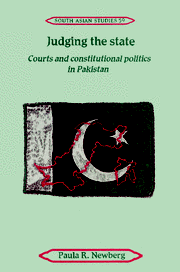Book contents
- Frontmatter
- Contents
- Preface
- Introduction
- 1 Structuring the state
- 2 Constituting the state (1947–1958)
- 3 Confining courts and constitutions (1958–1969)
- 4 Seeking justice (1969–1972)
- 5 Testing courts and constitutionalism (1972–1977)
- 6 Silencing courts, muting justice (1977–1988)
- 7 Reviving judicial powers (1988–1993)
- 8 Judging the state
- Table of cases
- Bibliography
- Index
- Cambridge South Asian Studies
2 - Constituting the state (1947–1958)
Published online by Cambridge University Press: 06 January 2010
- Frontmatter
- Contents
- Preface
- Introduction
- 1 Structuring the state
- 2 Constituting the state (1947–1958)
- 3 Confining courts and constitutions (1958–1969)
- 4 Seeking justice (1969–1972)
- 5 Testing courts and constitutionalism (1972–1977)
- 6 Silencing courts, muting justice (1977–1988)
- 7 Reviving judicial powers (1988–1993)
- 8 Judging the state
- Table of cases
- Bibliography
- Index
- Cambridge South Asian Studies
Summary
And sovereignty
Will belong to the people
Which means
You, I, and all of us.
Faiz Ahmad Faiz, “We will see.”Revolutions are not in the contemplation of those who frame constitutions.
Justice Muhammad MunirViewed schematically, the political course of independent Pakistan can be seen in microcosm in its first years. Many of the internal structures and external pressures that have come to typify state and society were present at its creation. The uncertainties of its relationship with India – bound so closely in history, ruptured so profoundly while successfully achieving self-determination – deeply permeated the country's political psychology and created the basis for a politics of uncertainty that remains today. Contentious and unstable regional relations influenced the way Pakistan organized its resources, foreign alliances and domestic politics, and quickly created the foundations for a praetorian state. The predominance of the military, even under civilian rule, colored the development of the country's laws and political institutions and equally, the ways its citizens responded to the proclaimed imperatives of the state. Its geographic and economic maps were mismatched and unbalanced: natural resources, capital and infrastructure were organized to fit unpartitioned, colonial India rather than the new state; politics were an awkward overlay on this terrain of nascent centers and multiple peripheries.
Pakistan was truly a product of many imaginations, each with their own visions of political community and state structure.
- Type
- Chapter
- Information
- Judging the StateCourts and Constitutional Politics in Pakistan, pp. 35 - 68Publisher: Cambridge University PressPrint publication year: 1995



